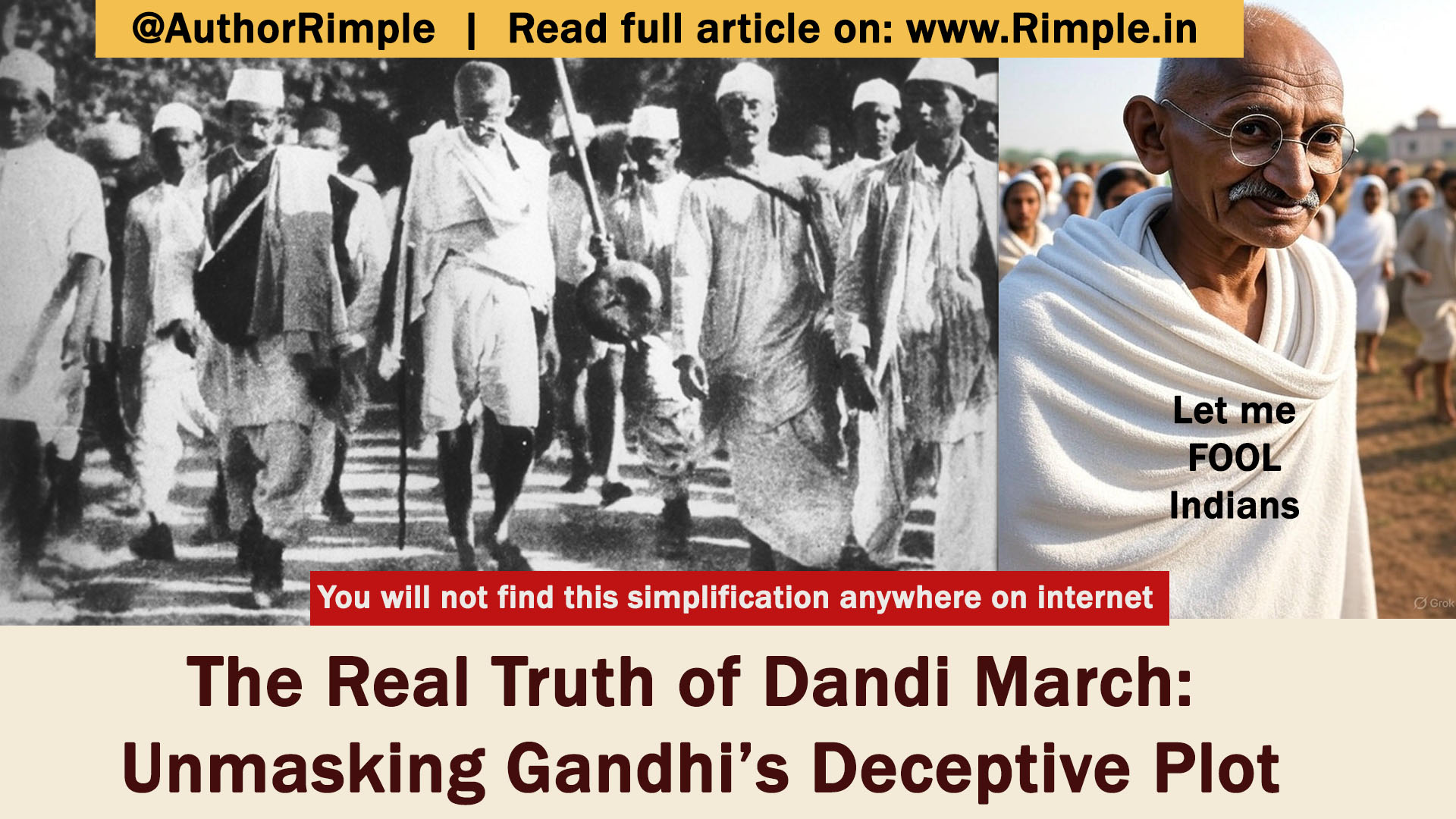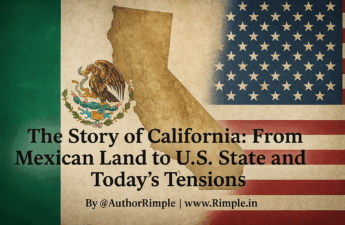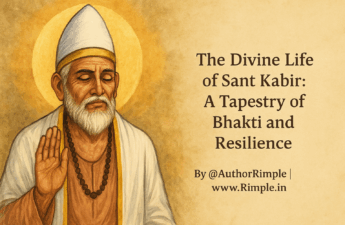For years, Indians have been taught to worship Mahatma Gandhi as the “Father of the Nation,” praising his Dandi Salt March as a heroic act of defiance against British rule. But what if this was all a carefully crafted lie? What if the Dandi March was not a step toward freedom but a trap to crush true Indian patriots? Let’s uncover the shocking truth behind this so-called “nonviolent protest” and expose how Gandhi’s actions served the British, betrayed India’s real freedom fighters like Veer Savarkar, Bhagat Singh, and Subhash Chandra Bose, and fooled millions of Indians.
What Was the Dandi March?
In March 1930, Gandhi led a 24-day march from his Sabarmati Ashram in Gujarat to the coastal village of Dandi, covering about 240 miles. The goal, he claimed, was to protest the British salt tax by making salt from seawater, defying the British monopoly. On April 6, 1930, Gandhi picked up a handful of salt, breaking the law, and urged others to do the same. This act sparked the Civil Disobedience Movement, with thousands joining in, only to face brutal British crackdowns.
Sounds inspiring, right? But let’s dig deeper. Was the salt tax really worth such a grand protest? And why did Gandhi, who was supposed to be fighting the British, end up cozying up to them while real patriots suffered?
The Salt Tax: A Tiny Issue Blown Out of Proportion
To understand the Dandi March, we need to look at the salt tax itself. The British had a monopoly on salt production and sales, taxing every grain of salt Indians used. Gandhi called this tax unfair, saying it hurt the poor the most. But let’s break it down with a simple example:
- A family of five uses about 5 kilos of salt a year.
- In 1930, this salt might have cost Rs. 125 annually, with the tax being a small part of it—say, Rs. 10–20.
- Compare this to the British looting treasures like the Kohinoor diamond, gold from temples, and silver from palaces, worth millions!
The salt tax was a drop in the bucket for the British. It made up less than 8% of their tax revenue and was barely worth the cost of collecting it. If the British wanted to oppress Indians, they were busy plundering far bigger riches. So why did Gandhi make such a big deal about salt? Was it really about freedom, or was it a distraction to trap brave Indians?
Gandhi’s Clever Trap: The Dandi March Exposed
Gandhi’s Dandi March wasn’t the noble protest history books claim. It was a cunning plan that played right into British hands. Here’s how it worked:
- Emotional Manipulation: Gandhi used loud speeches and media hype to stir emotions, calling the salt tax a great injustice. He rallied lakhs of Indians—Hindus, Muslims, Sikhs, and others—from different regions to join the march. People believed they were fighting for freedom.
- Oath of Nonviolence: Gandhi made every marcher swear an oath of nonviolence. This meant they couldn’t fight back, even when attacked. They were sitting ducks, unarmed and defenseless.
- Leading to Slaughter: On reaching Dandi, Gandhi “courted arrest” as planned, meaning he willingly let the British jail him. While he was whisked away to a comfortable prison, the British sealed off exits and unleashed violence on the marchers. Thousands were beaten with lathis, injured, or killed. Lakhs were arrested, their properties confiscated, and their lives ruined with police records.
- Gandhi’s Comfortable Life: While ordinary Indians suffered, Gandhi was treated like a VIP by the British. After his arrest, he was kept in a “luxurious” jail with special privileges. Later, he was released and even dined with British officials, including Viceroy Lord Irwin, in 1931. They signed the Gandhi-Irwin Pact, which gave no real gains to Indians but allowed Gandhi to attend fancy meetings in London.
This wasn’t a one-time trick. Gandhi repeated such protests, like the Dharasana Salt Works march, where more Indians were beaten and jailed. Each time, he stayed safe while his followers faced the British lathis. The result? The public grew tired, scared, and hopeless, too broken to demand real freedom.
Gandhi’s British Connections: No Ordinary Freedom Fighter
While true freedom fighters like Bhagat Singh, Subhash Chandra Bose, and Veer Savarkar risked their lives, Gandhi’s actions raise serious questions. Why was he so friendly with the British? Here’s what history reveals:
- Gandhi met and dined with British officials, including Viceroy Lord Irwin, after the Dandi March. These weren’t tense negotiations but polite, friendly meetings.
- He was invited to London for the Round Table Conference in 1931, treated like a celebrity while real revolutionaries were hanged or jailed in brutal conditions.
- Unlike Bhagat Singh, who was executed at 23, or Savarkar, who endured torture in the Andaman jails, Gandhi faced no harsh punishment. His jail time was more like a vacation, with books, writing materials, and comfortable quarters.
These facts suggest Gandhi wasn’t fighting the British but working with them. Some historians even argue he was a British spy, planted to weaken India’s real freedom struggle. His nonviolent protests disarmed Indians, making it easy for the British to crush them.
The Real Heroes: Savarkar, Bhagat Singh, and Bose
While Gandhi led Indians into traps, true patriots like Veer Savarkar, Bhagat Singh, and Subhash Chandra Bose fought with courage and strategy. Here’s how they differed:
- Veer Savarkar: A fierce revolutionary, Savarkar believed in armed resistance. He formed secret groups like Abhinav Bharat to attack British rule directly. He would have warned Indians against marching openly into British traps. Instead, he’d have urged them to hide in jungles, strike silently, and target lone British officers. Savarkar’s book on the 1857 Revolt inspired countless fighters, but Gandhi’s nonviolence overshadowed his call for action.
- Bhagat Singh: At just 21, Bhagat Singh bombed the Central Assembly to protest British laws. He avenged Lala Lajpat Rai’s death by killing a British officer. Unlike Gandhi, he refused to beg for mercy and was hanged at 23, shouting “Inquilab Zindabad” (Long Live the Revolution). His sacrifice inspired millions, but Gandhi condemned his violence, calling it wrong.
- Subhash Chandra Bose: Netaji formed the Indian National Army (INA) to fight the British with force. He allied with Germany and Japan, liberated Andaman and Nicobar Islands, and raised the Indian flag there. Bose rejected Gandhi’s nonviolence, saying, “Give me blood, and I will give you freedom.” While Gandhi dined with the British, Bose died fighting for India.
These heroes believed in action, not surrender. They knew the British wouldn’t leave by polite marches but by force and sacrifice. Gandhi’s Dandi March, by contrast, weakened the spirit of resistance.
How Gandhi Fooled Indians
Gandhi’s genius was in making Indians believe he was their savior. He used simple symbols like salt and the charkha (spinning wheel) to seem like a man of the people. But let’s see how he fooled us:
- The Salt Myth: Gandhi chose salt because it was a small, emotional issue. Everyone uses salt, so it was easy to rally people. But the tax was minor compared to the British looting India’s wealth. By focusing on salt, Gandhi distracted Indians from bigger issues like economic exploitation.
- Nonviolence as a Shackle: His strict nonviolence oath left marchers defenseless. When British troops attacked, they couldn’t fight back. This wasn’t bravery—it was a setup to let the British win.
- Media Manipulation: Gandhi’s marches were covered widely, making him a global hero. But this fame hid the suffering of jailed and injured marchers. The world saw Gandhi as a saint, not the British brutality he enabled.
The Aftermath: A Broken Spirit
The Dandi March and similar protests didn’t bring freedom. Instead, they:
- Filled British jails with lakhs of Indians, many injured or dead.
- Created police records that ruined families’ lives and livelihoods.
- Scared people away from future protests, as they feared arrest or violence.
- Strengthened British control by disarming and dividing Indians.
By 1931, when Gandhi signed the Gandhi-Irwin Pact, the British made no major concessions. The salt tax continued, and India was still under British rule. Gandhi’s protests delayed real freedom, which came only in 1947 after the sacrifices of fighters like Bose and the INA shook the British.
Why Indians Still Call Him Mahatma
Even today, Indians call Gandhi “Mahatma” (Great Soul), blind to his betrayals. Why? Because the British and their allies wrote our history books. They painted Gandhi as the hero to hide the real fighters like Savarkar, Bhagat Singh, and Bose. Schools teach us about the Dandi March but not about the INA’s battles or Savarkar’s torture in the Andamans. This is a deliberate attempt to keep Indians ignorant of their true heroes.
Wake Up, India!
The Dandi March was no victory—it was a trap that crushed India’s spirit. Gandhi’s nonviolence disarmed our people, while his British connections kept him safe. True freedom fighters like Veer Savarkar, Bhagat Singh, and Subhash Chandra Bose fought with their lives, not empty gestures. It’s time to question the “Mahatma” myth and honor the real heroes who bled for India’s freedom.
Let’s stop celebrating the Dandi March as a triumph. Instead, let’s remember the lakhs of Indians who suffered because of it. Let’s salute Savarkar’s secret plots, Bhagat Singh’s bombs, and Bose’s army. They, not Gandhi, brought us closer to 1947. India deserves the truth—no more lies about a British spy in a dhoti.
Also Read:





